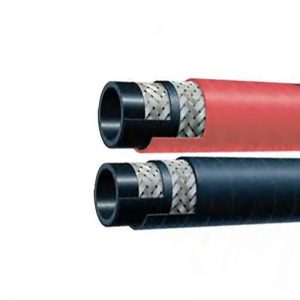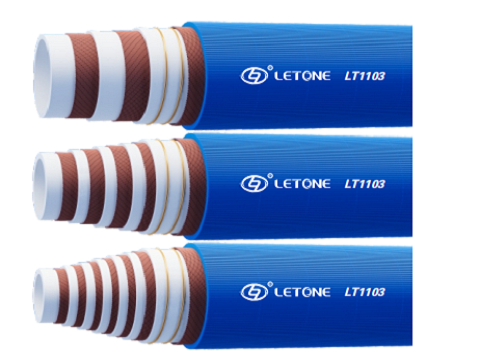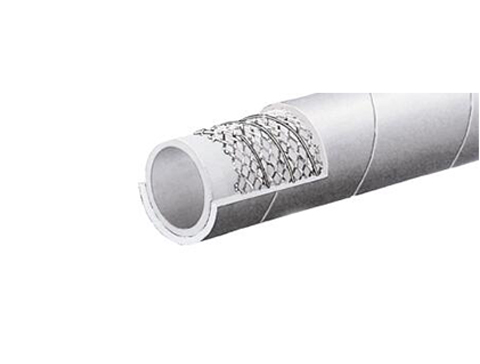In industrial production and daily life, air hoses, especially air rubber hoses, play an indispensable role. They are widely used in various fields such as pneumatic tools, hydraulic systems, automation equipment, agricultural irrigation, automobile maintenance, and home gardening due to their unique flexibility, pressure resistance, corrosion resistance, and easy installation and maintenance. This article will delve into the structure, performance characteristics, application scenarios, maintenance, and future development trends of air rubber hoses, in order to provide readers with a comprehensive and in-depth understanding.
1、 Structural analysis of air rubber hose
Air rubber hoses are mainly composed of three parts: an inner rubber layer, a reinforcement layer, and an outer rubber layer. The inner rubber layer directly contacts the transmission medium and is often made of materials such as nitrile rubber, natural rubber, or synthetic rubber to ensure good sealing and medium resistance. The reinforcement layer is the core of the hose, usually made up of multiple layers of fiber weaving or steel wire weaving, providing the necessary strength and compressive strength for the hose. The outer rubber layer serves to protect the inner layer, prevent external damage and UV aging, and is usually made of wear-resistant and aging resistant rubber materials.
 2、 Performance characteristics
1. Flexibility: Air rubber hoses have good bending performance, can adapt to various complex working environments, and are easy to install and use.
2. Pressure resistance: The presence of the reinforcement layer enables the hose to withstand high working pressures, ensuring transmission efficiency and safety.
3. Corrosion resistance: The selection of inner adhesive layer material enables the hose to have good resistance to various chemical media, extending its service life.
4. Wear resistance: The wear-resistant design of the outer rubber layer effectively reduces the wear of the hose during use and improves durability.
5. Temperature resistance: Some hoses made of special materials can maintain stable performance over a wide temperature range and adapt to different working conditions.
3、 Application scenarios
1. Pneumatic tools: In factories, workshops, and other places, air rubber hoses are important components that connect air sources and pneumatic tools, such as pneumatic wrenches, pneumatic grinders, etc.
2. Hydraulic system: Although mainly used for gas transmission, air rubber hoses can also play a role in certain hydraulic systems, especially in low-pressure situations.
3. Automation equipment: In automated production lines, hoses serve as flexible connectors to connect various pneumatic components and achieve automated control.
4. Agricultural irrigation: In the agricultural field, hoses are used in irrigation systems, and their flexibility and wear resistance make them an ideal choice for farmland irrigation.
5. Car maintenance: In car repair shops, air rubber hoses are used to connect air pumps with various pneumatic tools to improve maintenance efficiency.
4、 Maintenance and upkeep
1. Regular inspection: Regularly inspect the appearance of the hose to see if there is wear, aging, cracking, or deformation, and replace damaged hoses in a timely manner.
2. Avoid twisting: During use and storage, excessive twisting or bending of the hose should be avoided to prevent damage to the reinforcement layer and affect its service life.
3. Cleaning and maintenance: Regularly clean the surface of the hose, remove oil and impurities, keep the hose dry, and prevent corrosion.
4. Correct installation: Install the hose correctly according to the instructions, ensuring a tight connection and preventing air leakage.
5. Storage environment: When storing hoses, they should be placed in a cool, dry, and ventilated place, avoiding direct sunlight and high temperature environments.
5、 Future Development Trends
With the continuous development of industrial automation, the demand for air rubber hoses will continue to grow. In the future, the hose industry will pay more attention to material innovation and application, and develop more environmentally friendly, high-performance, and long-life hose products. At the same time, intelligent and customized production models will become a trend to meet the personalized needs of different customers. In addition, with the rise of new energy and environmental protection industries, the hose industry will also usher in new development opportunities, such as developing specialized hose products suitable for new energy vehicles, solar photovoltaics, and other fields.
In short, air rubber hoses play an irreplaceable role as important components for connection and transmission in industrial production and daily life. By understanding its structure, performance characteristics, application scenarios, and maintenance methods, we can better use and maintain hoses, improve production efficiency and quality of life. At the same time, paying attention to industry development trends and keeping up with the pace of technological innovation will bring us more convenience and surprises.
2、 Performance characteristics
1. Flexibility: Air rubber hoses have good bending performance, can adapt to various complex working environments, and are easy to install and use.
2. Pressure resistance: The presence of the reinforcement layer enables the hose to withstand high working pressures, ensuring transmission efficiency and safety.
3. Corrosion resistance: The selection of inner adhesive layer material enables the hose to have good resistance to various chemical media, extending its service life.
4. Wear resistance: The wear-resistant design of the outer rubber layer effectively reduces the wear of the hose during use and improves durability.
5. Temperature resistance: Some hoses made of special materials can maintain stable performance over a wide temperature range and adapt to different working conditions.
3、 Application scenarios
1. Pneumatic tools: In factories, workshops, and other places, air rubber hoses are important components that connect air sources and pneumatic tools, such as pneumatic wrenches, pneumatic grinders, etc.
2. Hydraulic system: Although mainly used for gas transmission, air rubber hoses can also play a role in certain hydraulic systems, especially in low-pressure situations.
3. Automation equipment: In automated production lines, hoses serve as flexible connectors to connect various pneumatic components and achieve automated control.
4. Agricultural irrigation: In the agricultural field, hoses are used in irrigation systems, and their flexibility and wear resistance make them an ideal choice for farmland irrigation.
5. Car maintenance: In car repair shops, air rubber hoses are used to connect air pumps with various pneumatic tools to improve maintenance efficiency.
4、 Maintenance and upkeep
1. Regular inspection: Regularly inspect the appearance of the hose to see if there is wear, aging, cracking, or deformation, and replace damaged hoses in a timely manner.
2. Avoid twisting: During use and storage, excessive twisting or bending of the hose should be avoided to prevent damage to the reinforcement layer and affect its service life.
3. Cleaning and maintenance: Regularly clean the surface of the hose, remove oil and impurities, keep the hose dry, and prevent corrosion.
4. Correct installation: Install the hose correctly according to the instructions, ensuring a tight connection and preventing air leakage.
5. Storage environment: When storing hoses, they should be placed in a cool, dry, and ventilated place, avoiding direct sunlight and high temperature environments.
5、 Future Development Trends
With the continuous development of industrial automation, the demand for air rubber hoses will continue to grow. In the future, the hose industry will pay more attention to material innovation and application, and develop more environmentally friendly, high-performance, and long-life hose products. At the same time, intelligent and customized production models will become a trend to meet the personalized needs of different customers. In addition, with the rise of new energy and environmental protection industries, the hose industry will also usher in new development opportunities, such as developing specialized hose products suitable for new energy vehicles, solar photovoltaics, and other fields.
In short, air rubber hoses play an irreplaceable role as important components for connection and transmission in industrial production and daily life. By understanding its structure, performance characteristics, application scenarios, and maintenance methods, we can better use and maintain hoses, improve production efficiency and quality of life. At the same time, paying attention to industry development trends and keeping up with the pace of technological innovation will bring us more convenience and surprises.







